Guangyu Wang
MinerU2.5: A Decoupled Vision-Language Model for Efficient High-Resolution Document Parsing
Sep 26, 2025Abstract:We introduce MinerU2.5, a 1.2B-parameter document parsing vision-language model that achieves state-of-the-art recognition accuracy while maintaining exceptional computational efficiency. Our approach employs a coarse-to-fine, two-stage parsing strategy that decouples global layout analysis from local content recognition. In the first stage, the model performs efficient layout analysis on downsampled images to identify structural elements, circumventing the computational overhead of processing high-resolution inputs. In the second stage, guided by the global layout, it performs targeted content recognition on native-resolution crops extracted from the original image, preserving fine-grained details in dense text, complex formulas, and tables. To support this strategy, we developed a comprehensive data engine that generates diverse, large-scale training corpora for both pretraining and fine-tuning. Ultimately, MinerU2.5 demonstrates strong document parsing ability, achieving state-of-the-art performance on multiple benchmarks, surpassing both general-purpose and domain-specific models across various recognition tasks, while maintaining significantly lower computational overhead.
Semantic Energy: Detecting LLM Hallucination Beyond Entropy
Aug 20, 2025Abstract:Large Language Models (LLMs) are being increasingly deployed in real-world applications, but they remain susceptible to hallucinations, which produce fluent yet incorrect responses and lead to erroneous decision-making. Uncertainty estimation is a feasible approach to detect such hallucinations. For example, semantic entropy estimates uncertainty by considering the semantic diversity across multiple sampled responses, thus identifying hallucinations. However, semantic entropy relies on post-softmax probabilities and fails to capture the model's inherent uncertainty, causing it to be ineffective in certain scenarios. To address this issue, we introduce Semantic Energy, a novel uncertainty estimation framework that leverages the inherent confidence of LLMs by operating directly on logits of penultimate layer. By combining semantic clustering with a Boltzmann-inspired energy distribution, our method better captures uncertainty in cases where semantic entropy fails. Experiments across multiple benchmarks show that Semantic Energy significantly improves hallucination detection and uncertainty estimation, offering more reliable signals for downstream applications such as hallucination detection.
DISCOVERSE: Efficient Robot Simulation in Complex High-Fidelity Environments
Jul 29, 2025Abstract:We present the first unified, modular, open-source 3DGS-based simulation framework for Real2Sim2Real robot learning. It features a holistic Real2Sim pipeline that synthesizes hyper-realistic geometry and appearance of complex real-world scenarios, paving the way for analyzing and bridging the Sim2Real gap. Powered by Gaussian Splatting and MuJoCo, Discoverse enables massively parallel simulation of multiple sensor modalities and accurate physics, with inclusive supports for existing 3D assets, robot models, and ROS plugins, empowering large-scale robot learning and complex robotic benchmarks. Through extensive experiments on imitation learning, Discoverse demonstrates state-of-the-art zero-shot Sim2Real transfer performance compared to existing simulators. For code and demos: https://air-discoverse.github.io/.
MedSG-Bench: A Benchmark for Medical Image Sequences Grounding
May 17, 2025Abstract:Visual grounding is essential for precise perception and reasoning in multimodal large language models (MLLMs), especially in medical imaging domains. While existing medical visual grounding benchmarks primarily focus on single-image scenarios, real-world clinical applications often involve sequential images, where accurate lesion localization across different modalities and temporal tracking of disease progression (e.g., pre- vs. post-treatment comparison) require fine-grained cross-image semantic alignment and context-aware reasoning. To remedy the underrepresentation of image sequences in existing medical visual grounding benchmarks, we propose MedSG-Bench, the first benchmark tailored for Medical Image Sequences Grounding. It comprises eight VQA-style tasks, formulated into two paradigms of the grounding tasks, including 1) Image Difference Grounding, which focuses on detecting change regions across images, and 2) Image Consistency Grounding, which emphasizes detection of consistent or shared semantics across sequential images. MedSG-Bench covers 76 public datasets, 10 medical imaging modalities, and a wide spectrum of anatomical structures and diseases, totaling 9,630 question-answer pairs. We benchmark both general-purpose MLLMs (e.g., Qwen2.5-VL) and medical-domain specialized MLLMs (e.g., HuatuoGPT-vision), observing that even the advanced models exhibit substantial limitations in medical sequential grounding tasks. To advance this field, we construct MedSG-188K, a large-scale instruction-tuning dataset tailored for sequential visual grounding, and further develop MedSeq-Grounder, an MLLM designed to facilitate future research on fine-grained understanding across medical sequential images. The benchmark, dataset, and model are available at https://huggingface.co/MedSG-Bench
scDrugMap: Benchmarking Large Foundation Models for Drug Response Prediction
May 08, 2025Abstract:Drug resistance presents a major challenge in cancer therapy. Single cell profiling offers insights into cellular heterogeneity, yet the application of large-scale foundation models for predicting drug response in single cell data remains underexplored. To address this, we developed scDrugMap, an integrated framework featuring both a Python command-line interface and a web server for drug response prediction. scDrugMap evaluates a wide range of foundation models, including eight single-cell models and two large language models, using a curated dataset of over 326,000 cells in the primary collection and 18,800 cells in the validation set, spanning 36 datasets and diverse tissue and cancer types. We benchmarked model performance under pooled-data and cross-data evaluation settings, employing both layer freezing and Low-Rank Adaptation (LoRA) fine-tuning strategies. In the pooled-data scenario, scFoundation achieved the best performance, with mean F1 scores of 0.971 (layer freezing) and 0.947 (fine-tuning), outperforming the lowest-performing model by over 50%. In the cross-data setting, UCE excelled post fine-tuning (mean F1: 0.774), while scGPT led in zero-shot learning (mean F1: 0.858). Overall, scDrugMap provides the first large-scale benchmark of foundation models for drug response prediction in single-cell data and serves as a user-friendly, flexible platform for advancing drug discovery and translational research.
ClinicalGPT-R1: Pushing reasoning capability of generalist disease diagnosis with large language model
Apr 15, 2025Abstract:Recent advances in reasoning with large language models (LLMs)has shown remarkable reasoning capabilities in domains such as mathematics and coding, yet their application to clinical diagnosis remains underexplored. Here, we introduce ClinicalGPT-R1, a reasoning enhanced generalist large language model for disease diagnosis. Trained on a dataset of 20,000 real-world clinical records, ClinicalGPT-R1 leverages diverse training strategies to enhance diagnostic reasoning. To benchmark performance, we curated MedBench-Hard, a challenging dataset spanning seven major medical specialties and representative diseases. Experimental results demonstrate that ClinicalGPT-R1 outperforms GPT-4o in Chinese diagnostic tasks and achieves comparable performance to GPT-4 in English settings. This comparative study effectively validates the superior performance of ClinicalGPT-R1 in disease diagnosis tasks. Resources are available at https://github.com/medfound/medfound.
Privacy-Preserving Federated Foundation Model for Generalist Ultrasound Artificial Intelligence
Nov 25, 2024



Abstract:Ultrasound imaging is widely used in clinical diagnosis due to its non-invasive nature and real-time capabilities. However, conventional ultrasound diagnostics face several limitations, including high dependence on physician expertise and suboptimal image quality, which complicates interpretation and increases the likelihood of diagnostic errors. Artificial intelligence (AI) has emerged as a promising solution to enhance clinical diagnosis, particularly in detecting abnormalities across various biomedical imaging modalities. Nonetheless, current AI models for ultrasound imaging face critical challenges. First, these models often require large volumes of labeled medical data, raising concerns over patient privacy breaches. Second, most existing models are task-specific, which restricts their broader clinical utility. To overcome these challenges, we present UltraFedFM, an innovative privacy-preserving ultrasound foundation model. UltraFedFM is collaboratively pre-trained using federated learning across 16 distributed medical institutions in 9 countries, leveraging a dataset of over 1 million ultrasound images covering 19 organs and 10 ultrasound modalities. This extensive and diverse data, combined with a secure training framework, enables UltraFedFM to exhibit strong generalization and diagnostic capabilities. It achieves an average area under the receiver operating characteristic curve of 0.927 for disease diagnosis and a dice similarity coefficient of 0.878 for lesion segmentation. Notably, UltraFedFM surpasses the diagnostic accuracy of mid-level ultrasonographers and matches the performance of expert-level sonographers in the joint diagnosis of 8 common systemic diseases. These findings indicate that UltraFedFM can significantly enhance clinical diagnostics while safeguarding patient privacy, marking an advancement in AI-driven ultrasound imaging for future clinical applications.
A Time Series is Worth Five Experts: Heterogeneous Mixture of Experts for Traffic Flow Prediction
Sep 26, 2024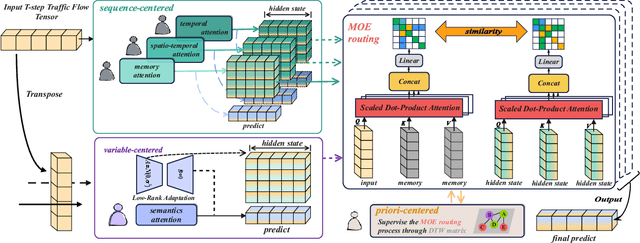
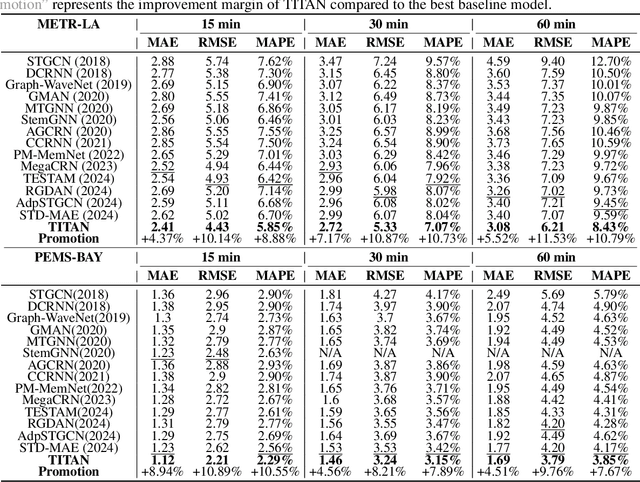


Abstract:Accurate traffic prediction faces significant challenges, necessitating a deep understanding of both temporal and spatial cues and their complex interactions across multiple variables. Recent advancements in traffic prediction systems are primarily due to the development of complex sequence-centric models. However, existing approaches often embed multiple variables and spatial relationships at each time step, which may hinder effective variable-centric learning, ultimately leading to performance degradation in traditional traffic prediction tasks. To overcome these limitations, we introduce variable-centric and prior knowledge-centric modeling techniques. Specifically, we propose a Heterogeneous Mixture of Experts (TITAN) model for traffic flow prediction. TITAN initially consists of three experts focused on sequence-centric modeling. Then, designed a low-rank adaptive method, TITAN simultaneously enables variable-centric modeling. Furthermore, we supervise the gating process using a prior knowledge-centric modeling strategy to ensure accurate routing. Experiments on two public traffic network datasets, METR-LA and PEMS-BAY, demonstrate that TITAN effectively captures variable-centric dependencies while ensuring accurate routing. Consequently, it achieves improvements in all evaluation metrics, ranging from approximately 4.37\% to 11.53\%, compared to previous state-of-the-art (SOTA) models. The code is open at \href{https://github.com/sqlcow/TITAN}{https://github.com/sqlcow/TITAN}.
Expert-level vision-language foundation model for real-world radiology and comprehensive evaluation
Sep 24, 2024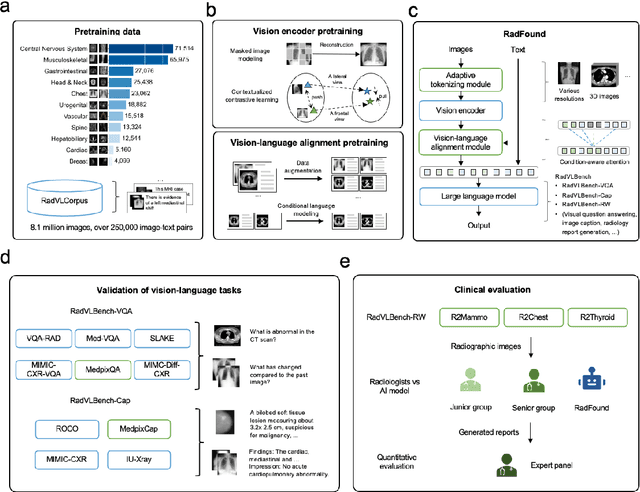
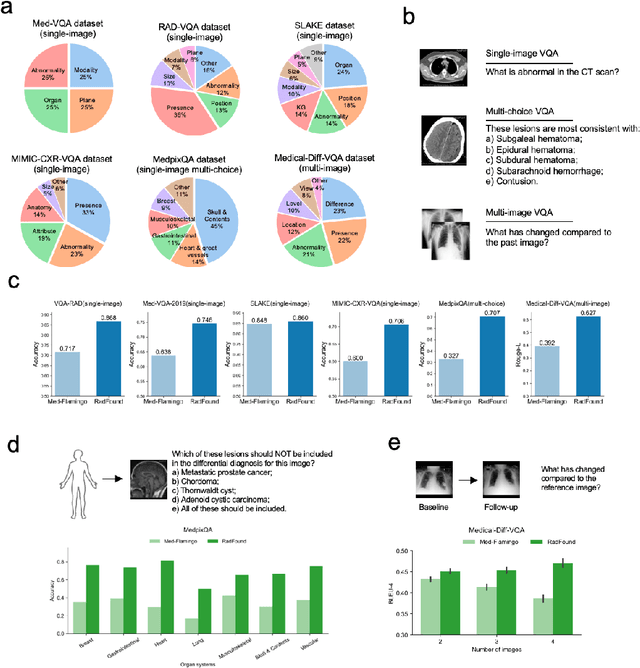
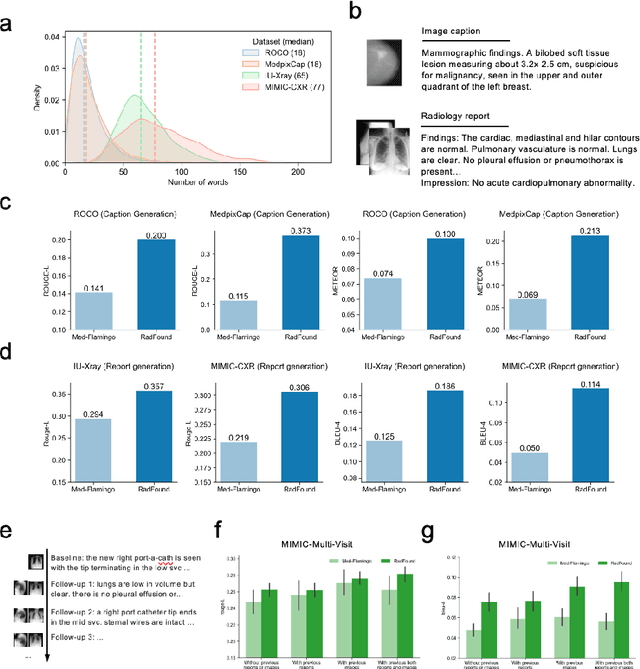
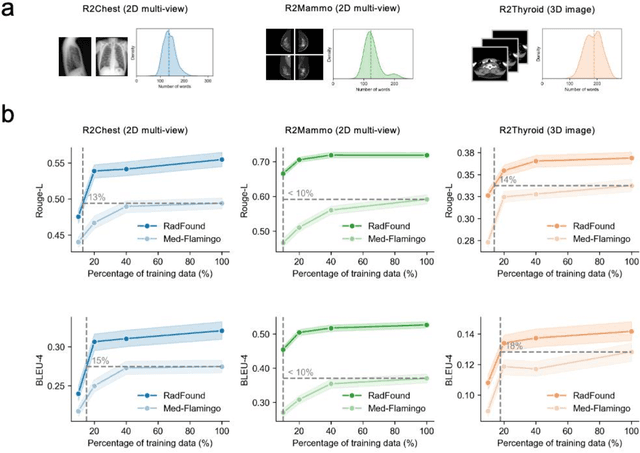
Abstract:Radiology is a vital and complex component of modern clinical workflow and covers many tasks. Recently, vision-language (VL) foundation models in medicine have shown potential in processing multimodal information, offering a unified solution for various radiology tasks. However, existing studies either pre-trained VL models on natural data or did not fully integrate vision-language architecture and pretraining, often neglecting the unique multimodal complexity in radiology images and their textual contexts. Additionally, their practical applicability in real-world scenarios remains underexplored. Here, we present RadFound, a large and open-source vision-language foundation model tailored for radiology, that is trained on the most extensive dataset of over 8.1 million images and 250,000 image-text pairs, covering 19 major organ systems and 10 imaging modalities. To establish expert-level multimodal perception and generation capabilities, RadFound introduces an enhanced vision encoder to capture intra-image local features and inter-image contextual information, and a unified cross-modal learning design tailored to radiology. To fully assess the models' capability, we construct a benchmark, RadVLBench, including radiology interpretation tasks like medical vision-language question-answering, as well as text generation tasks ranging from captioning to report generation. We also propose a human evaluation framework. When evaluated on the real-world benchmark involving three representative modalities, 2D images (chest X-rays), multi-view images (mammograms), and 3D images (thyroid CT scans), RadFound significantly outperforms other VL foundation models on both quantitative metrics and human evaluation. In summary, the development of RadFound represents an advancement in radiology generalists, demonstrating broad applicability potential for integration into clinical workflows.
SA-FedLora: Adaptive Parameter Allocation for Efficient Federated Learning with LoRA Tuning
May 15, 2024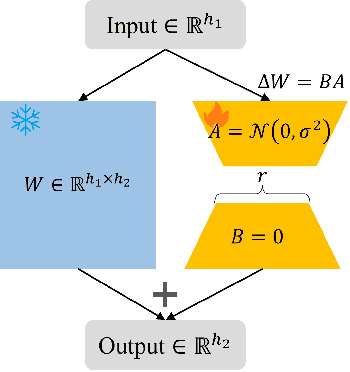

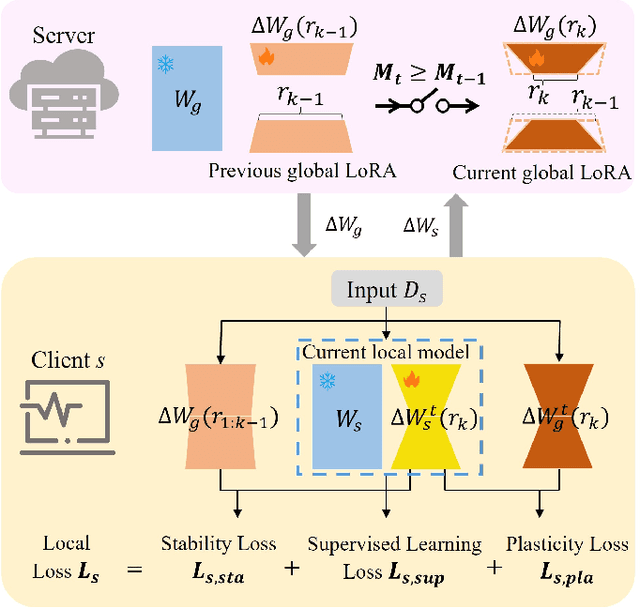

Abstract:Fine-tuning large-scale pre-trained models via transfer learning is an emerging important paradigm for a wide range of downstream tasks, with performance heavily reliant on extensive data. Federated learning (FL), as a distributed framework, provides a secure solution to train models on local datasets while safeguarding raw sensitive data. However, FL networks encounter high communication costs due to the massive parameters of large-scale pre-trained models, necessitating parameter-efficient methods. Notably, parameter efficient fine tuning, such as Low-Rank Adaptation (LoRA), has shown remarkable success in fine-tuning pre-trained models. However, prior research indicates that the fixed parameter budget may be prone to the overfitting or slower convergence. To address this challenge, we propose a Simulated Annealing-based Federated Learning with LoRA tuning (SA-FedLoRA) approach by reducing trainable parameters. Specifically, SA-FedLoRA comprises two stages: initiating and annealing. (1) In the initiating stage, we implement a parameter regularization approach during the early rounds of aggregation, aiming to mitigate client drift and accelerate the convergence for the subsequent tuning. (2) In the annealing stage, we allocate higher parameter budget during the early 'heating' phase and then gradually shrink the budget until the 'cooling' phase. This strategy not only facilitates convergence to the global optimum but also reduces communication costs. Experimental results demonstrate that SA-FedLoRA is an efficient FL, achieving superior performance to FedAvg and significantly reducing communication parameters by up to 93.62%.
 Add to Chrome
Add to Chrome Add to Firefox
Add to Firefox Add to Edge
Add to Edge